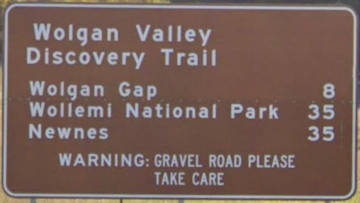In 1906, the Newnes township and shale oil mining complex was established, extracting low-grade oil from shale. The Newnes mining complex ceased operations and restarted until 1931 when it last ceased.
Newnes was named after Sir George Newnes, who was one of the principle directors of the Commonwealth Oil Corporation Limitied.
Over the range is Glen Davis, another township established for the shale oil industry, to secure oil production for national security interests. Established after Newnes ceased operations, it was thought to be an easier location to access rather than re-establish the railway into Newnes. Another township, Joadja in the NSW Southern Highlands, first mined shale much earlier in 1875.
Oil Shale is a carbon sediment similar to coal, however, oil shale is generally any rock which produces oil when heated. High grade oil shale is known as Torbanite, derived from the Scottish town Torbane where oil shale was first mined. Torbanite found at Newnes is light in weight and greasy to the touch. It looks black or dark green with a silky sheen.
When Torbanite is heated, gases are released. A synthetic crude oil can be recovered from the liquid produced by condensing the gases. Refining the crude oil further produces petrol, kerosene, lubricating oils, fuel oil, paraffin wax, tar, acids and pitch. It is crazy to think that Joadja used to burn off diesel as a by-product, before the diesel engine was invented in the late 1890s.
The low-grade from Newnes and high-grade ore exported to the UK and USA, combined with an increase of production of natural crude oil overseas, eventually led to the operations ending at Newnes. The high cost involved in the extraction and production processes contributed to the Commonwealth Oil Corporation Limited to fail.
Newnes Township
There is not much remaining of the Newnes township. The dwellings were built when needed and when spare time allowed. With limited spare time and crude building materials, many of the buildings didn’t survive.
It didn’t take long for full production to be reached in 1907, with the peak of the town in 1911 seeing around 1,600 people living in Newnes, and around 50 to 60 children. Very different to Newnes 2021 census showing 7 people and no children.
A teacher’s residence was constructed in 1924, not long before the shale oil works first ceased production. Two large chimneys show where the teacher’s residence once stood. School children were accommodated in a building near the town’s hall which was also used as a church, Sunday School, and the Men’s Reading Room.
The Newnes Hotel is the only standing building left of the township. The hotel itself moved from its original location after the flood prone area undermined the hotel. It now operates as an information kiosk and museum on weekends, as well as offering cabins to stay at.
Newnes Industrial Ruins Walk
The ruins are accessible along a walk, either starting from the township or from a 4WD accessible parking area. From the township, the walk is around 5 kilometres. It takes around 3 hours, however, depending on how quickly you walk and how much time you spend looking around.
Allowing another hour or so will give you more time to look around. If you have a 4WD, the 4WD accessible parking area takes approximately 2 kilometers off the walk, saving around 45 minutes.
After crossing the river at the ford, turn right to find a stone platform, part of the original route of the Wolgan Valley railway line.
Newnes Railway Station Precinct
The railway station is all but gone. The only remaining structure is the stone-faced railway platform. It was originally a 110-foot timber faced platform with a ticket office and waiting room. A wooden footbridge let residents cross the river before being washed away in a storm in 1910. Despite protests, the footbridge was not replaced.
A goods shed was located to the south of the platform near a goods siding. Gates were installed over the roadway and railway line slightly to the north. The buildings were in use until the railway closed in 1932.
To continue the walk, head back towards the ford, continuing for around 1.5km passed the campgrounds.
Coke and Coal Mines
The coke ovens are a unique set of beehive kilns built before 1907, used until 1911. The kilns were built in two rows of 60 back to back, a total of 120 kilns. Most of the kilns remain with some in good condition. The original stone facade was removed for the Newnes station platform and other buildings.
Coal was placed into ovens, super-heated in the absence of air and converted to coke. The coal mine complex behind the kilns has been destroyed.
Works Reservoir
A large concrete tank provided water for most of the different areas of production within the complex. Water was pumped from the river upsteam of the main plant and piped to this storage tank from where it was gravity-fed to the various workshops on the site.
Brick Retaining Wall and Shale Storage Bin Site
The brick retaining wall is one of a group built when the foundations were prepared for the exhauster house, ammonia scrubbers, and retort stands. At the site of the storage bin to the right of the large brick retaining wall, pieces of shale could be found on the ground.
Shale was mined and transported across the river to this point via an elevated haulage gantry. Remains of the foundations of this structure can be seen in the vicinity.
Wax Production Area and Paraffin Sheds
Knee-high foundations and a retaining wall area are all that remain of the wax production area and wax sweating plant. A boiling vat, firebox, and chimney is nearby. The substantial remains of the building below the wax production area belong to the paraffin shed – the only building on the site which stands to roof level.
Workshop Complex
A brick and concrete slab floor is all that remains of the Workshop Complex.
Retorts and Associated Equipment
Most of this section of the site is built on terraces, held back by massive retaining walls of up to 20 metres high. The bench of retorts was the heart of the whole complex. It is a long mound of rubble up to 3 metres high with piers of brick appearing in places.
Water Separator and Power House
The dirty water, concrete lined pond, and separator is in good condition. The 200-foot chimney and boiler area are now a pile of bricks, a few metres high. The power house foundations, next to this rubble, are comprised of two large rectangular concrete pits with several anchorage bolts attached.
Distillation Area
Most of the distillation area comprises of ground level foundations. The charging tanks for the crude oil, heavy oil, and paraffin oil distillation plants stand on a level above them. Two 150-foot chimneys for the distilling plants have been demolished, with many of the brings removed.
There four distilling benches, however, they have largely deteriorated. The crude oil distilling plant is the best preserved in this set of features.
Ruins on the North Bank of the Wolgan River
Over the other side of the Wolgan River are more ruins of the Newnes Oil Shale mining site. The oil works office complex included the works surgery, telephone exchange and offices.
Most of the bricks used in the works were made at Newnes, with a clay quarry, press house, brick kilns, and drying house. The Newnes bricks are distinctive in that they are slightly heavier and larger than a standard house brick. Supplies of the bricks were occasionally shipped to construction sites in nearby towns.
The house site and garden on the northern bank of the Wolgan River had a prominent position overlooking the reiver and the entire works site. It is possibly the works manager’s residence. The house was set amidst plantings of exotic trees.
Water Supply Pump
Continuing along the river back towards the railway platform, on the south bank is a prominent concrete platform. This is where the water supply pump was located. It pumped water from the river to the Works Reservoir high on the hills.
Campgrounds
There are two sets of campgrounds at Newnes. Both campsites are in the Wollomi National Park ![]() . There are no camping fees but you need to book and there is a $6 booking fee.
. There are no camping fees but you need to book and there is a $6 booking fee.
The first is accessible on the same side of the river as the Newnes Hotel, about 800 metres further along Wolgan Rd. It is a beautiful open grass area, positioned under the cliffs surrounding the Wolgan Valley. The road into Newnes is gravel but is generally accessible with 2WD vehicles and this campground is accessible as well. Be aware the track into the campground is simpler than the road into Newnes and mud holes can form on the track during wet weather. There are toilets and wood barbecue pits, but bring your own firewood.
The second campground is accessed by crossing over the Wolgan River and only accessible by 4WD. The ford over the river is around 250 metres on the right from the Newnes Hotel. After crossing the river, turn left and the campgrounds are around 500 metres along. There are wood barbecue pits, but bring your own firewood. The Newnes Industrial Ruins walk is shorter from this campsite, although, the railway platform is in the opposite direction after crossing the river.


